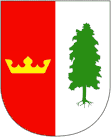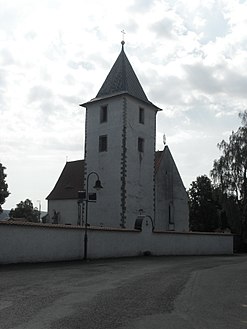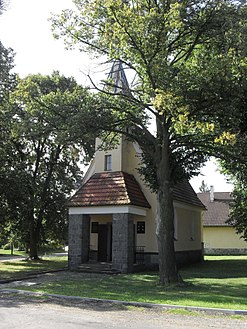Velký Bor
| Velký Bor | ||||
|---|---|---|---|---|
|
||||
| Basic data | ||||
| State : |
|
|||
| Region : | Plzeňský kraj | |||
| District : | Klatovy | |||
| Area : | 1,785.0213 ha | |||
| Geographic location : | 49 ° 22 ' N , 13 ° 42' E | |||
| Height: | 452 m nm | |||
| Residents : | 554 (Jan. 1, 2019) | |||
| Postal code : | 341 01 | |||
| License plate : | P | |||
| traffic | ||||
| Street: | Horažďovice - Nepomuk | |||
| Railway connection: | České Budějovice – Plzeň | |||
| structure | ||||
| Status: | local community | |||
| Districts: | 3 | |||
| administration | ||||
| Mayor : | Václav Zábranský (status: 2014) | |||
| Address: | Velký Bor 71 341 01 Horažďovice |
|||
| Municipality number: | 557382 | |||
| Website : | www.sumavanet.cz/velkybor | |||
Velký Bor (German Groß Bor , 1939–45 Großheid ) is a municipality in the Czech Republic . It is located five kilometers north of Horažďovice and belongs to the Okres Klatovy .
geography
Velký Bor is located in the Blatenská pahorkatina hill country. The village lies on a hill Na hradě on the right side of the brook Březový potok , into which the brooks Hájek and Velkoborský potok flow. On the southern outskirts of Velký Bor lies the Velkoborský rybník or Podkostelák pond. To the southeast rises the Rážek (461 m), in the south the Kališových vršek (471 m) and the Bílá voda (473 m) and west of the Boubínský (512 m). The state road II / 188 between Horažďovice and Životice leads through Velký Bor , from which the road II / 177 branches off to Lnáře in the village . The railway line České Budějovice – Plzeň runs two kilometers south and west, the Velký Bor stop is in the Na Šumavě settlement.
Neighboring towns are U Pazderny, Barák, Placek, Defurovy Łazany, Újezd u Chanovic, Holkovice and Dobrotice in the north, Slatina , Lnářský Málkov and Svéradice in the Northeast, Slivonice, Komušín and Mečichov the east, Hlupín and Babín the southeast, Na Šumavě and Horažďovice in South, Malý Bor and Horažďovická Lhota in the southwest, Velešice and Pačejov in the west and Jetenovice, Maňovice and Osek in the northwest.
history
Bor was probably founded in the 12th or 13th century. In the small town laid out below a royal castle in the outer bailey there was a parish church with a parsonage belonging to the Prachiner deanery.
The first written mention of the place took place in 1283, when King Wenceslas II left the castle to the Bohemian chamberlain Dietrich Spatzmann ( Dětřich Špatzman ). In 1304 Wenceslas II exchanged the Bor castle with Botho von Bothenstein ( Půta z Potštejna ) for half of the Lititz castle . Botho von Bothenstein died without descendants; his property, which in addition to the Bor castle with the town of Bor and the village of Dobrotice also included eleven villages behind Schüttenhofen and the northern Bohemian village of Drahoňovice, fell to the Zderaz monastery in 1336. The Zderazer Kreuzherren entrusted the administration of their rule Bor to a burgrave. Since that time, the town has been called the Kreuzherren Bor ( Bor Křižovnický ) to distinguish it from the nearby lordly Bor ( Bor Panský ) . At the end of the 14th century, the knight Dobeš von Bor took possession of the castle, and King Wenceslaus IV had him expelled before 1401.
After the destruction of the Nepomuk monastery , the Hussites besieged and conquered Bor Panský , which was inhabited by many Germans , but probably Bor Křižovnický , on October 12, 1420 , and set the castle on fire. As compensation for the damage suffered by the Hussites during the subsequent conquest of Rabí Castle , King Sigismund pledged the same year a. a. the rule Bor to his followers Johann and Wilhelm d. J. von Riesenberg ; Bor castle was not mentioned. When Jan Žižka's army moved from Slatina to Horažďovice on the way to the second siege of Rabí Castle in the summer of 1421 , the burnt-out castle was captured again and completely destroyed. The church was also ruined. The Bor castle was not rebuilt, its ruins were later gradually demolished. King George of Podebrady left the rule of Bor Větší to Břeněk of Rabí. After his death, the widow Anna von Rabí inherited the estate together with her children Jan and Eliška. Eliška von Rabí bequeathed the property to her uncle around 1519, who combined the Bor Větší rule with his Horažďovice rule.
During the Thirty Years War , Velký Bor was destroyed again; in the Berní rula of 1654 the place was described as desolate. The parish of the expired Velký Bor parish was assigned to the Malý Bor parish. In 1682 there were again 29 farms in Velký Bor, and there were two chalupners in the village . The owner of the Horažďovice estate, Wenceslaus von Sternberg , had a pastor reinstated in Velký Bor in 1700. There is evidence of local judges in Velký Bor since 1716. In 1727 the place consisted of 29 farmers and three Chalupners.
Maria Princess von Löwenstein-Wertheim had the last remains of the wall of Bor Castle removed. According to their last will, a hospital with 24 places for old servants of the Horažďovice estate, financed from a donation of 50,000 guilders, was built on the site of the castle in 1765, in the east wing of which there was a chapel. In the course of the Josephine reforms , the hospital and chapel were closed in 1788. Since 1791 there was a school in Velký Bor; Since there was no permanent school house in the village, lessons were initially held in different houses. In 1810, 686 people lived in the 88 houses of Velký Bor. In 1816 a new schoolhouse (house no. 2) was built opposite the rectory. Until the middle of the 19th century, Velký Bor remained subject to the Horažďowitz rule.
After the abolition of patrimonial formed Velký Bor / Great Bor after 1850 a municipality in the judicial district Horažďowitz. In 1863 the school moved to the former hospital. From 1868 the municipality of Velký Bor belonged to the Strakonice District . In the same year, traffic on the České Budějovice – Plzeň railway was started, but Velký Bor was only given a train stop in the 20th century. In 1869 the Velký Bor municipality bought the former hospital and converted it into a school building. The volunteer fire brigade was founded in 1891. In 1898 a cooperative savings and loan fund ( Kampelička ) was established. Their treasurer, the teacher Jan Stulík, embezzled deposits amounting to 27,000 crowns and emigrated to America in 1909. On August 11, 1925, the dams of all the smaller ponds broke during a strong flood, only the Velkoborský rybník withstood the floods. As the flood destroyed all road bridges, Velký Bor was cut off from the outside world for a while. The Velký Bor water cooperative began regulating streams and improving meadows and fields in November 1925 . On November 20, 1925, it was connected to the electricity network. On September 1, 1934, the municipality made the meadow behind the Velkoborský rybník available to the local football club for the construction of a field. After the end of the Second World War, an American prison camp was set up on May 6, 1945 in the fields on the Bílá voda. From 1949 Velký Bor belonged to the Okres Horažďovice, after its abolition the municipality was assigned to the Okres Klatovy in 1960. On July 1, 1975, Jetenovice was incorporated. Maňovice was umgemeindet on January 1, 1976 from Pačejov to Velký Bor. On July 1, 1980 Svéradice (with Slivonice) was incorporated. Svéradice became independent again in 1990, Maňovice in early 1992. The school in Velký Bor was closed in 2001 due to insufficient student numbers.
Community structure
The municipality of Velký Bor consists of the districts and cadastral districts Jetenovice ( Jettenowitz ), Slivonice ( Sliwonitz ) and Velký Bor ( Groß Bor ). Velký to boron also includes the local situation and the Podkostelák monolayer Na Šumavěm, Osek and U Pazderny.
The district of Slivonice forms an exclave separated from the rest of the municipality by the municipality of Svéradice.
Attractions
- Church of John the Baptist in Velký Bor, it was probably built in the 13th century and was originally a castle and later monastery church of St. Consecrated to Burian. Later she became the hll. Consecrated to Peter and Paul and served as a hospital church. It was repaired between 1970 and 1977.
- Chapel of St. Anna, east of Velký Bor, the 150-year-old lime tree standing next to it fell over on July 12, 2006
- Memorial stone for TGMasaryk and the fallen of World War I on the village square, unveiled in 1929
- Chapel in Jetenovice
- Attractions
Sons and daughters of the church
- Sylvestr Krnka (1825–1903), Bohemian gunsmith and designer of a new form of breech loader, father of the arms manufacturer and designer Karel Krnka ( Roth-Steyr M1907 )
- Jan Pastejřík (1869–1968), Czech naturalist and textbook author
- Bohumil Ullrych (1893–1948), Czech painter
Individual evidence
- ↑ http://www.uir.cz/obec/557382/Velky-Bor
- ↑ Český statistický úřad - The population of the Czech municipalities as of January 1, 2019 (PDF; 7.4 MiB)
- ↑ Archived copy ( memento of the original from June 25, 2014 in the Internet Archive ) Info: The archive link was inserted automatically and has not yet been checked. Please check the original and archive link according to the instructions and then remove this notice.
- ↑ http://www.uir.cz/casti-obce-obec/557382/Obec-Velky-Bor
- ↑ http://www.uir.cz/katastralni-uzemi-obec/557382/Obec-Velky-Bor
Web links





